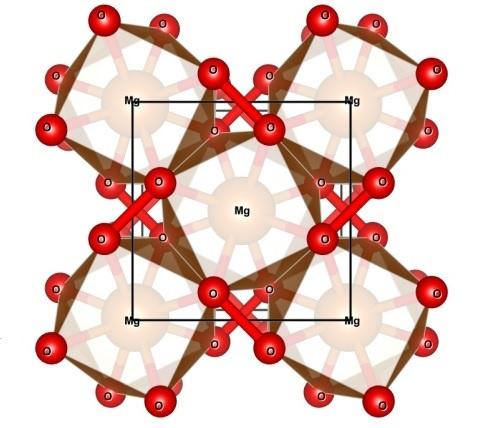Distant planet's interior chemistry may differ from our own

This is the crystal structure of magnesium peroxide, MgO2, courtesy of Sergey Lobanov, created using K. Momma's program for drawing crystal structures. Credit: Sergey Lobanov
Oxygen and magnesium are the two most-abundant elements in Earth's mantle. However, when scientists are predicting the chemical compositions of rocky, terrestrial planets outside of our own Solar System, they shouldn't assume that other rocky planets would have Earth-like mantle mineralogy, according to a research team including Carnegie's Sergey Lobanov, Nicholas Holtgrewe, and Alexander Goncharov.
Stars that have rocky planets are known to vary in chemical composition. This means that the mineralogies of these rocky planets are probably different from each other and from our own Earth, as well. For example, elevated oxygen contents have been observed in stars that host rocky planets. As such, oxygen may be more abundant in the interiors of other rocky planets, because the chemical makeup of a star would affect the chemical makeups of the planets that formed around it. If a planet is more oxidized than Earth, then this could affect the composition of the compounds found in its interior, too, including the magnesium compounds that are the subject of this study.
Magnesium oxide, MgO, is known to be remarkably stable, even under very high pressures. And it isn't reactive under the conditions found in Earth's lower mantle. Whereas magnesium peroxide, MgO2, can be formed in the laboratory under high-oxygen concentrations, but it is highly unstable when heated, as would be the case in a planetary interior.
Previous theoretical calculations had indicated that magnesium peroxide would become stable under high-pressure conditions. Taking that idea one step further, the team set out to test whether stable magnesium peroxide could be synthesized under extreme conditions mimicking planetary interiors.
Using a laser-heated, diamond-anvil cell, they brought very small samples of magnesium oxide and oxygen to different pressures meant to mimic planetary interiors, from ambient pressure to 1.6 million times normal atmospheric pressure (0-160 gigapascals), and heated them to temperatures above 3,140 degrees Fahrenheit (2,000 Kelvin). They found that under about 950,000 times normal atmospheric pressure (96 gigapascals) and at temperatures of 3,410 degrees Fahrenheit (2,150 Kelvin), magnesium oxide reacted with oxygen to form magnesium peroxide.
“Our findings suggest that magnesium peroxide may be abundant in extremely oxidized mantles and cores of rocky planets outside our Solar System,” said Lobanov, the paper's lead author “When we develop theories about distant planets, it's important that we don't assume their chemistry and mineralogy is Earth-like.”
“These findings provide yet another example of the ways that high-pressure laboratory experiments can teach us about not only our own planet, but potentially about distant ones as well,” added Goncharov.
Because of its chemical inertness, MgO has also long been used as a conductor that transmits heat and pressure to an experimental sample. “But this new information about its chemical reactivity under high pressure means that such experimental uses of MgO need to be revised, because it they could be creating unwanted reactions and affecting results,” Goncharov added.
###
The other co-authors are Qiang Zhu and Artem Oganov of Stony Brook University and Clemens Prescher and Vitali Prakapenka of University of Chicago.
This study was funded by the Deep Carbon Observatory, the National Science Foundation, DARPA, the Government of the Russian Federation, and the Foreign Talents Introduction and Academic Exchange Program. Calculations were performed on XSEDE facilities and on the cluster of the Center for Functional Nonomaterials Brookhaven National Laboratory, which is supported by the DOE-BES.
The Carnegie Institution for Science (carnegiescience.edu) is a private, nonprofit organization headquartered in Washington, D.C., with six research departments throughout the U.S. Since its founding in 1902, the Carnegie Institution has been a pioneering force in basic scientific research. Carnegie scientists are leaders in plant biology, developmental biology, astronomy, materials science, global ecology, and Earth and planetary science.
Media Contact
All latest news from the category: Physics and Astronomy
This area deals with the fundamental laws and building blocks of nature and how they interact, the properties and the behavior of matter, and research into space and time and their structures.
innovations-report provides in-depth reports and articles on subjects such as astrophysics, laser technologies, nuclear, quantum, particle and solid-state physics, nanotechnologies, planetary research and findings (Mars, Venus) and developments related to the Hubble Telescope.
Newest articles

A ‘language’ for ML models to predict nanopore properties
A large number of 2D materials like graphene can have nanopores – small holes formed by missing atoms through which foreign substances can pass. The properties of these nanopores dictate many…

Clinically validated, wearable ultrasound patch
… for continuous blood pressure monitoring. A team of researchers at the University of California San Diego has developed a new and improved wearable ultrasound patch for continuous and noninvasive…

A new puzzle piece for string theory research
Dr. Ksenia Fedosova from the Cluster of Excellence Mathematics Münster, along with an international research team, has proven a conjecture in string theory that physicists had proposed regarding certain equations….



